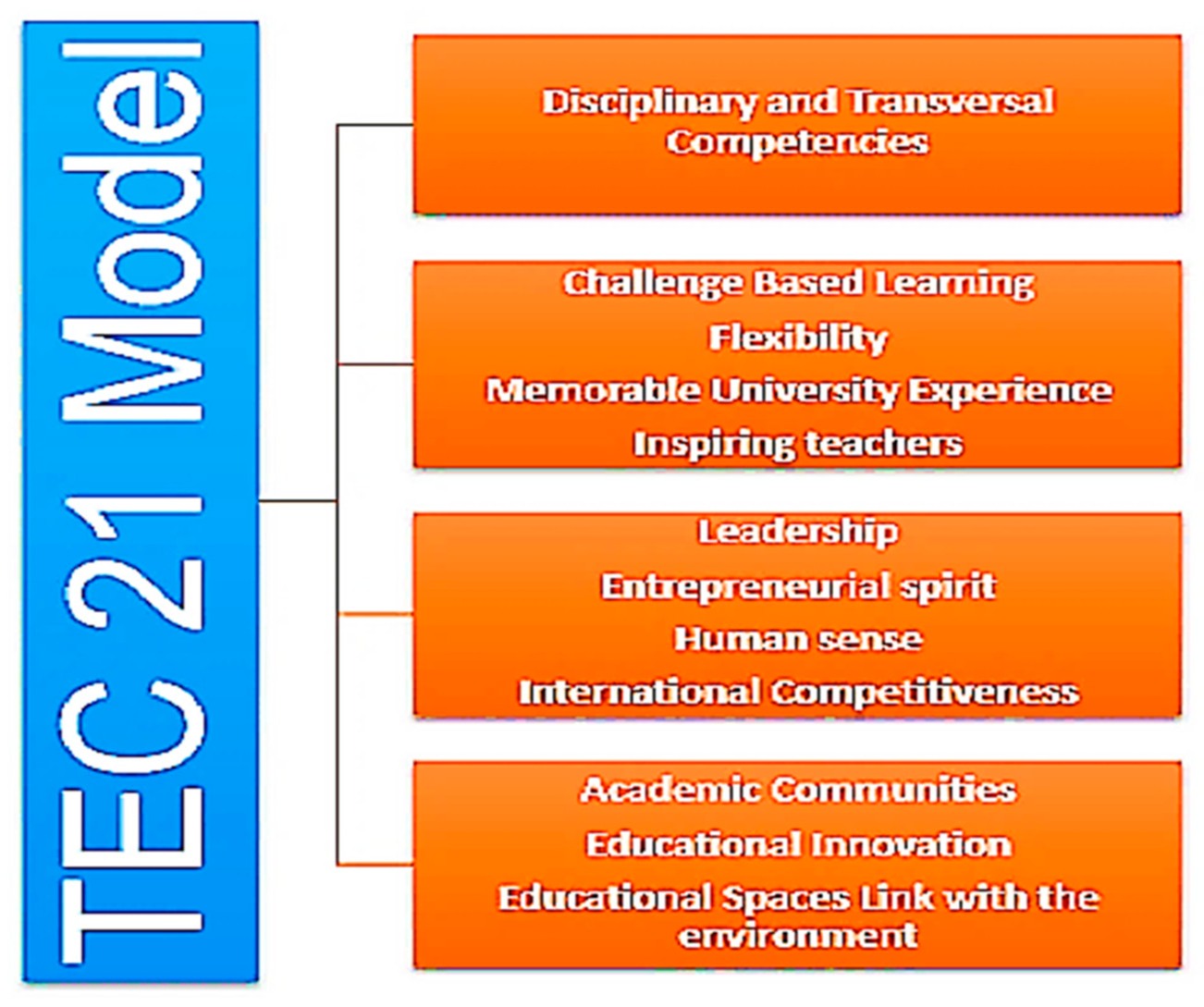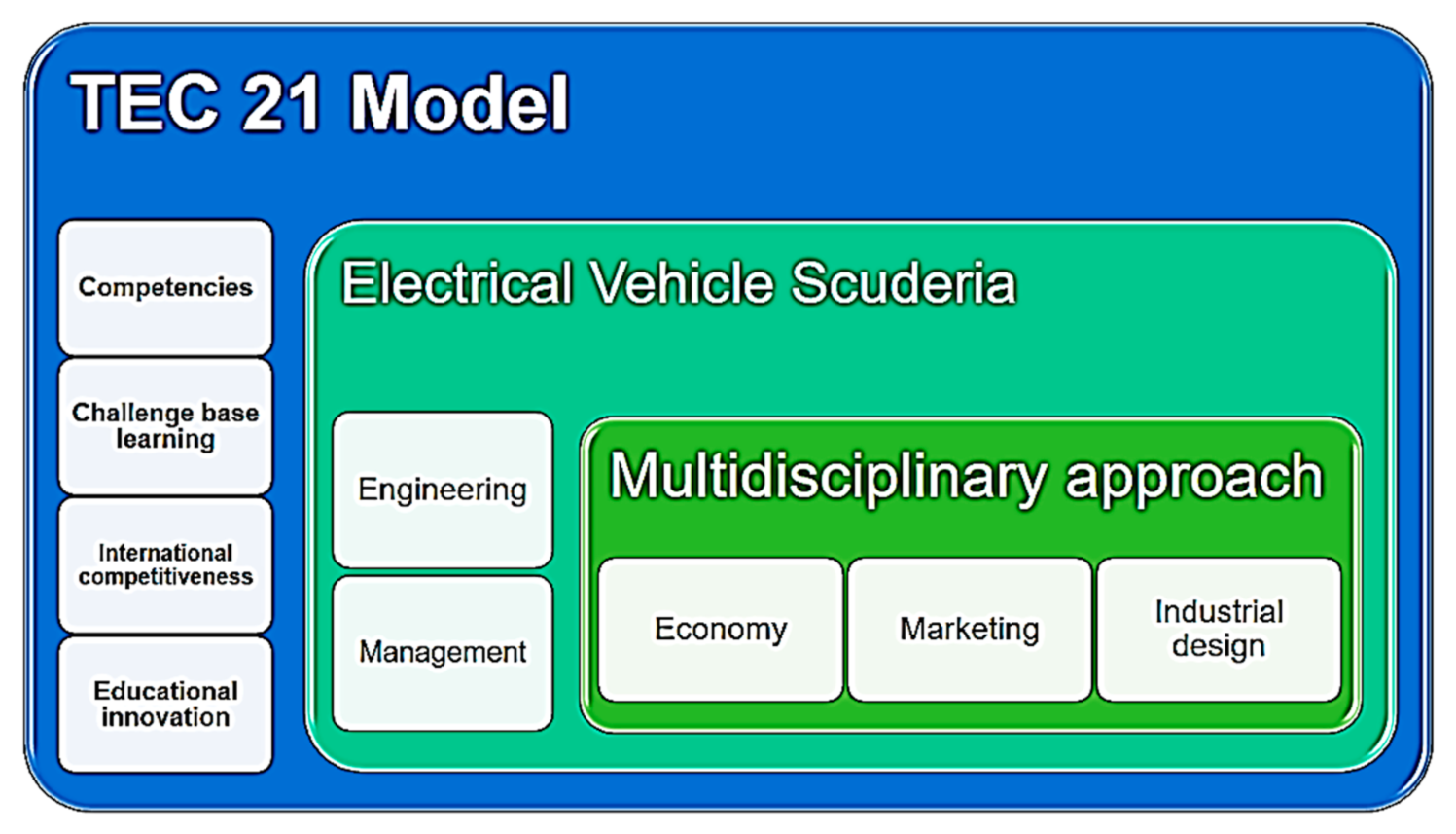Suspension System of an “Electraton” and “Formula SAE” Competition
As background related to the case study, there are precedents of a Tec university project on the Mexico City campus where research and tests were carried out in laboratories with physical prototypes. The objective was to improve the performance of an electric vehicle’s front suspension system. The traditional suspension system is a set of passive elements intended to minimize road disturbances and improve the vehicle’s dynamic performances. It must be designed for the suspension to react optimally during driving, affecting the vehicle’s center-of-mass movement as little as possible [
37].
Various design techniques can be implemented to minimize the dynamic effects that the vehicle may suffer. Several of these techniques can be found in the literature, but the methods’ verification is only theoretical. First, we take the example of the design of a suspension for the “Electraton” competition. In this championship contest, the suspension is of the utmost importance when developing the electric vehicle because of its dimensions. The regulations stipulate two limits for total length and width [
38].
Figure 6 shows the minimum dimensions.
Similarly, the regulations have a section that mentions that the suspension system should be independent, contemplating a McPherson-type or double wishbone design (see
Figure 7).
In either case, it must include a spring and shock absorber having a direct connection to the car’s main structure. The suspension system should provide an optimum height of at least 2″ (50.8 mm) from the ground in both front and rear suspension systems [
38]. Knowing the stipulated measures and components, we proceeded to design such a system; the main goal was to establish the center of mass. It enabled us to know the static loads that the vehicle would have and, consequently, the efforts required to generate the suspension. The equations used to establish the center of mass:
This equation shows us the sum of the different masses that are part of the vehicle.
We can also establish the distribution of each mass or component within a specific limit previously set by the regulations. We determined the longitudinal and height distribution of the vehicle with the following equations:
Equations (2) and (3) represent the longitudinal position and the resulting height of the center of mass (see
Figure 8).
By obtaining the total weight and estimating each component’s position in the vehicle, we could find the center of mass’s distance and height. This allowed us to define the vehicle’s weight distribution percentages, obtaining Wf and Wr, representing the weights in the front and rear sections.
The total mass of the vehicle of 225 kg, multiplied by the gravity constant “g” (9.81 m/s2), the total vehicle weight (W) is 2207.25 N.
With these weights defined, we could proceed to find a more suitable wheelbase (L) (the length of the front axle to the rear axle) to allow an optimal distribution of weight for the vehicle through the equation:
The wheelbase (L) obtained was 1353.14815 mm.
Table 1 shows the total of the measurements made, while center of mass and vehicle weight distribution are showed on
Table 2 and
Table 3, respectively.
These parameters allowed us to determine the load transfer of the vehicle during a race. In this case, we used an extreme situation for the front suspension during a hard cornering braking.
Figure 9 synthesizes this idea.
These loads were a preamble for static analysis of the components of the suspension system. Still, because a vehicle is a highly dynamic object, new complications arise when the vehicle passes over bumps and curbs. The “shock” loads are transmitted through the suspension to the main structure. The actual magnitude of these loads is difficult to determine. However, the design procedures indicated that applying a dynamic factor of “3” directly to the total weight of the vehicle [
37], together with the respective aerodynamic coefficients, was more than enough to simulate the vehicle dynamics behavior. We call these new charges “Design Loads”. In
Table 7,
Table 8 and
Table 9, it can see the main aspects of dynamic tests for vehicle.
These results provided an overview of the vehicle behavior in static and dynamic situations. We could use these data to determine:
Loads that affect the action of the suspension arms, whether lower or higher.
Behavior with other related systems.
Appropriate geometry or corresponding reinforcement for the suspension system, covering variables like camber, caster, instant-center, and roll-center.
Kinematic analysis for the suspension system mechanism.
Analysis of deformation in reinforcements corresponding to the suspension arms, theoretically, through simulations (FEM) and practice.
Properties such as stiffness and the damping coefficient required in the suspension system.
Motion ratio for push-and-pull-rod mechanisms.
With these design parameters already established, we could draw this system’s general schemes to actual scale, creating a complete system visualization (
Figure 10).
With this scheme presented in 2D complete and not showing visible obstructions or inconsistencies, we could make the system’s corresponding CAD drawings.
Figure 11,
Figure 12 and
Figure 13 illustrate this idea.
After these CAD drawings, we proceeded to perform a finite element model (FEM) analysis, through which each piece is submitted to its corresponding studies, contemplating its movement restrictions and the load characteristics to which it would be subjected. It is essential to bear in mind that even if these are simulations, they must comply with a specific mandatory safety factor contemplated in the design materials subject to different loads, as shown in
Figure 14.
Once the FEM simulations and their analyses with the corresponding safety factor were completed, we carried out the vehicle’s general assembly to evaluate the calculations previously made (
Figure 15).
With the simulations, design, and final assembly already established, each component’s prototype machining processes could begin, reviewing compliance with the appropriate tolerances for optimal practical functionality to avoid unnecessary waste of raw material.
Figure 16 shows this process.
The prototype’s functionality was satisfactory, so the different processes of the system manufacturing were carried out, such as Manual and CNC lathe, Manual and CNC milling, Welding, and 3D Printing.
Once the physical components are machined, they must be subjected to different resistance tests. For this testing, metric gauges are essential because they provide data on micro deformations at the points where the highest possible stresses can occur (
Figure 17 and
Figure 18). We could carry out the system’s final assembly with the tests satisfactorily performed for each interconnected system. The member (s) involved in this system must follow a series of crucial steps for the assembly, avoiding damaging any other vehicle system. Cooperation among the different vehicle systems teams is critical to obtain the best vehicle behavior during the competition.
In this case, the design of the suspension was for a national competition. Still, engineering complexity increases in the opportunity to participate in an international competition, the Formula Student (FSAE). In this competition, there are more restrictions regarding the suspension system, as discussed below:
The technical requirements specified in Article 6 of the general rules of the chassis (T6.1) and the general guidelines for the FSAE suspension system are:
T6.1.1. The vehicle must be equipped with an operating suspension system, with shock absorbers, front, and rear, having wheel travel of at least 15 mm to 50.8 mm during the boat, and bounce with the driver inside the cabin. Judges reserve the right to disqualify cars that do not present a serious attempt at an operational suspension system or demonstrate improper handling for a cross-car circuit [
36].
T6.1.2. All suspension mounting points must be visible on technical inspection, either by direct vision or by removing any cover [
36]. Below is a table that shows some of the requirements to consider in the design of a suspension.
With the design parameters mentioned in the previous specifications, it is possible to perform each of the steps mentioned in the case of “Electraton” for the suspension design in this competition, including:
Theoretical analyses of the center-of-mass, optimal track measurements, and vehicle load distributions.
Load transfer during different braking, acceleration, and cornering situations.
The geometry of camber, caster, instant center, and roll center.
Kinematic analysis of the suspension system.
Analysis of deformation in reinforcements corresponding to the suspension arms, theoretically, through simulations (FEM) and practice.
Properties such as stiffness and damping coefficient required in the suspension system.
Motion ratio for push or pull-rod systems, if used.
With these analyses and operations carried out, it is possible to obtain the components’ real-scale schematizations. Then, each element is subjected to static and dynamic tests, much stricter than those mentioned previously in the Electraton competition. In the FSAE competition tests, interdisciplinary and disciplinary competencies acquire more value since the vehicle’s data and general information are contemplated in engineering and economics, marketing, and administration. The competition judges evaluate verbal and body communication skills, teamwork, and work under pressure. The FSAE Tests include [
36]: Static events (Presentation, Cost, and Design) and Dynamic Events (Acceleration, Skid Pad, Autocross, Efficiency, and Endurance).
Once all of the tests on the suspension system components are submitted, the 2D scheme must be performed (
Figure 19).
If the scheme does not present problems in assembly, location, and design tolerances, we proceed to 3D modeling (CAD) of the suspension system’s components (
Figure 20).
These models must withstand the movement restrictions, and the characteristics of the loads analyzed using FEM simulations; locating the most significant stress points is possible through these simulations. FEM analysis results are illustrated in
Figure 21.
With the FEM analyses completed, it is possible to perform the general assembly of the vehicle.
Figure 22 shows the final assembly.

































